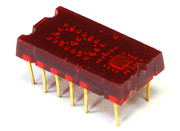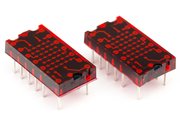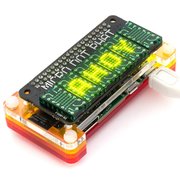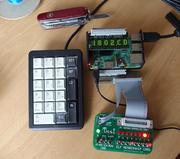
Difference: RaspiElfDisplay (1 vs. 13)
Revision 132018-09-28 - PeterSchmid
Revision 122018-06-16 - PeterSchmid
| Line: 1 to 1 | ||||||||
|---|---|---|---|---|---|---|---|---|
%DASHBOARD{ section="banner" | ||||||||
| Line: 14 to 14 | ||||||||
| Changed: | ||||||||
| < < | TIL311 hexadecimal displays were to expensive for me 35 years ago and now they are not easy to get (and still expensive). The 4×7 rounded font looks far better than the seven-segment display especially the lower case hex display letters. But there is an alternative: LTP-305 from LITEON. They have no integrated driver, but the matrix LED driver IC IS31FL3730 | |||||||
| > > | TIL311 hexadecimal displays were to expensive for me 35 years ago and now they are not easy to get (and still expensive). The 4×7 rounded font looks far better than the seven-segment display especially the lower case hex display letters. But there is an alternative: LTP-305 | |||||||
| | | | ||||||||
Revision 112018-05-31 - PeterSchmid
| Line: 1 to 1 | ||||||||
|---|---|---|---|---|---|---|---|---|
%DASHBOARD{ section="banner" | ||||||||
| Line: 6 to 6 | ||||||||
| title="!RaspiElf Display" titlestyle="color:#F00000;" }% | ||||||||
| Changed: | ||||||||
| < < | Intro
| |||||||
| > > | Intro
| |||||||
| Long time ago I built a LED display and a hex keypad for my COSMICOS. I lend the COSMICOS and the extensions to a friend's brother and I saw the parts never again. Thanks to Lee Hart's 1802 Membership Card | ||||||||
| Changed: | ||||||||
| < < | Contents
| |||||||
| > > | Contents
| |||||||
| Line: 59 to 59 | ||||||||
How to get and build the RaspiElf Display SoftwareTheelfdisplay is part of the RaspiElf tools package. See RaspiElf#How_to_get_and_build_the_RaspiEl | ||||||||
| Added: | ||||||||
| > > |
Operating Modes (shown by decimal points)Load
# ##### ### ##### ##### ######
## # # # # # # # # # #
# # # # # # # # # #
# ##### # # ##### # # #
# # # # # # # # #
# # # # # # # # # #
OOO ##### ##### ### ####### ### ##### ######
Run
# ##### ### ##### ##### ######
## # # # # # # # # # #
# # # # # # # # # #
# ##### # # ##### # # #
# # # # # # # # #
# # # # # # # # # #
##### OOO ##### ### ####### ### ##### ######
Wait
# ##### ### ##### ##### ######
## # # # # # # # # # #
# # # # # # # # # #
# ##### # # ##### # # #
# # # # # # # # #
# # # # # # # # # #
##### ##### OOO ### ####### ### ##### ######
Address
# ##### ### ##### ##### ######
## # # # # # # # # # #
# # # # # # # # # #
# ##### # # ##### # # #
# # # # # # # # #
# # # # # # # # # #
### ##### ##### ### OOO ####### ### ##### ######
Memory Protect
# ##### ### ##### ##### ######
## # # # # # # # # # #
# # # # # # # # # #
# ##### # # ##### # # #
# # # # # # # # #
# # # # # # # # # #
### ##### ##### ### ####### ### ##### OOO ######
| |||||||
|
| ||||||||
Revision 102018-05-20 - PeterSchmid
| Line: 1 to 1 | ||||||||
|---|---|---|---|---|---|---|---|---|
%DASHBOARD{ section="banner" | ||||||||
| Changed: | ||||||||
| < < | image="/twiki/pub/Cosmac/RaspiElf/raspi-elfmemcard-s.jpg" | |||||||
| > > | image="/twiki/pub/Cosmac/RaspiElfDisplay/keypad-display-s.jpg" | |||||||
| title="!RaspiElf Display" titlestyle="color:#F00000;" }% | ||||||||
| Line: 29 to 29 | ||||||||
Software for the Raspberry PiThe Raspi controls the display through its I2C interface. | ||||||||
| Changed: | ||||||||
| < < | I still want to use the 1802 Membership Card's | |||||||
| > > | I still want to use the 1802 Membership Card's | |||||||
|
There is Python Library and Examples for Micro Dot pHAT on GitHub | ||||||||
| Line: 58 to 58 | ||||||||
How to get and build the RaspiElf Display Software | ||||||||
| Changed: | ||||||||
| < < | The elfdisplay is part of the tools package. See RaspiElf#How_to_get_and_build_the_RaspiEl | |||||||
| > > | The elfdisplay is part of the RaspiElf tools package. See RaspiElf#How_to_get_and_build_the_RaspiEl | |||||||
|
| ||||||||
| Line: 80 to 80 | ||||||||
| ||||||||
| Changed: | ||||||||
| < < | Is somebody out there interested in a TIL311 emulator? Linux is not a Real Time Operating System (RTOS), and it is easy to miss a strobe signal, even if we use interrupts. | |||||||
| > > | Is anybody interested in a TIL311 emulator? The only problem to write a program for the Raspi is to be fast enough for the strobe signal. Linux is not a Real Time Operating System (RTOS), and it is easy to miss a strobe signal, even if we use interrupts. | |||||||
| Line: 95 to 95 | ||||||||
| ||||||||
| Added: | ||||||||
| > > |
| |||||||
Revision 92018-05-20 - PeterSchmid
| Line: 1 to 1 | ||||||||
|---|---|---|---|---|---|---|---|---|
%DASHBOARD{ section="banner" | ||||||||
| Line: 19 to 19 | ||||||||
|
| ||||||||
| Added: | ||||||||
| > > |
| |||||||
| Line: 93 to 94 | ||||||||
| ||||||||
| Added: | ||||||||
| > > |
| |||||||
Revision 82018-05-19 - PeterSchmid
| Line: 1 to 1 | ||||||||
|---|---|---|---|---|---|---|---|---|
%DASHBOARD{ section="banner" | ||||||||
| Line: 14 to 14 | ||||||||
| Changed: | ||||||||
| < < | TIL311 hexadecimal displays were to expensive for me 35 years ago and now they are not easy to get (and still expensive). The 4×7 rounded font looks far better than the seven-segment display especially the lower case hex display letters. But there is an alternative: LTP-305 from LITEON. They have no integrated driver, but the matrix LED driver IC IS31FL3730 | |||||||
| > > | TIL311 hexadecimal displays were to expensive for me 35 years ago and now they are not easy to get (and still expensive). The 4×7 rounded font looks far better than the seven-segment display especially the lower case hex display letters. But there is an alternative: LTP-305 from LITEON. They have no integrated driver, but the matrix LED driver IC IS31FL3730 | |||||||
| | | | ||||||||
| Line: 28 to 28 | ||||||||
Software for the Raspberry PiThe Raspi controls the display through its I2C interface. | ||||||||
| Changed: | ||||||||
| < < | I still want to use the 1802 Membership Card's | |||||||
| > > | I still want to use the 1802 Membership Card's | |||||||
|
There is Python Library and Examples for Micro Dot pHAT on GitHub | ||||||||
Revision 72018-05-17 - PeterSchmid
| Line: 1 to 1 | ||||||||
|---|---|---|---|---|---|---|---|---|
%DASHBOARD{ section="banner" | ||||||||
| Line: 28 to 28 | ||||||||
Software for the Raspberry PiThe Raspi controls the display through its I2C interface. | ||||||||
| Changed: | ||||||||
| < < | I still want to use the 1802 Membership Card's | |||||||
| > > | I still want to use the 1802 Membership Card's | |||||||
|
There is Python Library and Examples for Micro Dot pHAT on GitHub | ||||||||
Revision 62018-05-13 - PeterSchmid
| Line: 1 to 1 | ||||||||
|---|---|---|---|---|---|---|---|---|
%DASHBOARD{ section="banner" | ||||||||
| Line: 7 to 7 | ||||||||
| titlestyle="color:#F00000;"
}%
Intro
| ||||||||
| Changed: | ||||||||
| < < | Long time ago I built a LED display and a hex keypad for my COSMICOS. I lend the COSMICOS and the extensions to a friend's brother and I saw the parts never again. Thanks to Lee Hart's 1802 Membership Card | |||||||
| > > | Long time ago I built a LED display and a hex keypad for my COSMICOS. I lend the COSMICOS and the extensions to a friend's brother and I saw the parts never again. Thanks to Lee Hart's 1802 Membership Card | |||||||
| Changed: | ||||||||
| < < | ||||||||
| > > | ||||||||
HardwareTIL311 hexadecimal displays were to expensive for me 35 years ago and now they are not easy to get (and still expensive). The 4×7 rounded font looks far better than the seven-segment display especially the lower case hex display letters. But there is an alternative: LTP-305 from LITEON. They have no integrated driver, but the matrix LED driver IC IS31FL3730 | ||||||||
| Line: 30 to 30 | ||||||||
|
I still want to use the 1802 Membership Card's | ||||||||
| Changed: | ||||||||
| < < | There is Python Library and Examples for Micro Dot pHAT on GitHub | |||||||
| > > | There is Python Library and Examples for Micro Dot pHAT on GitHub | |||||||
|
Check for the I2C device:
| ||||||||
| Line: 54 to 54 | ||||||||
| 61, 62, and 63 are the I2C addresses of the IS31FL3730 chips. | ||||||||
| Changed: | ||||||||
| < < | ||||||||
| > > | ||||||||
How to get and build the RaspiElf Display Software | ||||||||
| Changed: | ||||||||
| < < | Get the source from the GIT repositorysudo apt-get install git), type only the bold text after the $ sign:
pi@cosmac:~/elf $ git clone https://github.com/spyren/RaspiElf Cloning into 'RaspiElf'... remote: Counting objects: 68, done. remote: Compressing objects: 100% (37/37), done. remote: Total 68 (delta 32), reused 62 (delta 29), pack-reused 0 Unpacking objects: 100% (68/68), done. Checking connectivity... done. pi@cosmac:~/elf $ | |||||||
| > > | The elfdisplay is part of the tools package. See RaspiElf#How_to_get_and_build_the_RaspiEl | |||||||
| Deleted: | ||||||||
| < < | Build (compile) from the sources:
pi@cosmac:~/elf $ cd RaspiElf pi@cosmac:~/elf/RaspiElf $ cd display/ pi@cosmac:~/elf/RaspiElf/display $ make ... TBCInstall the binaries into /usr/local/bin
pi@cosmac:~/elf/RaspiElf/display $ sudo make install ... TBC | |||||||
Revision 52018-05-07 - PeterSchmid
| Line: 1 to 1 | ||||||||
|---|---|---|---|---|---|---|---|---|
%DASHBOARD{ section="banner" | ||||||||
| Line: 7 to 7 | ||||||||
| titlestyle="color:#F00000;"
}%
Intro
| ||||||||
| Changed: | ||||||||
| < < | Long time ago I built a LED display and a hex keypad for my COSMICOS. I lend the COSMICOS and the extensions to a friend's brother and I saw the parts never again. Thanks to Lee Hart's 1802 Membership Card | |||||||
| > > | Long time ago I built a LED display and a hex keypad for my COSMICOS. I lend the COSMICOS and the extensions to a friend's brother and I saw the parts never again. Thanks to Lee Hart's 1802 Membership Card | |||||||
|
| ||||||||
| Changed: | ||||||||
| < < | TIL311 hexadecimal displays were to expensive for me 35 years ago and now they are not easy to get (and still expensive). The 4×7 rounded font looks far better than the seven-segment display especially the lower case hex display letters. But there is an alternative: LTP-305 from LITEON. They have no integrated driver, but the matrix LED driver IC IS31FL3730 | |||||||
| > > | TIL311 hexadecimal displays were to expensive for me 35 years ago and now they are not easy to get (and still expensive). The 4×7 rounded font looks far better than the seven-segment display especially the lower case hex display letters. But there is an alternative: LTP-305 from LITEON. They have no integrated driver, but the matrix LED driver IC IS31FL3730 | |||||||
| | | | ||||||||
| Line: 30 to 30 | ||||||||
|
I still want to use the 1802 Membership Card's | ||||||||
| Changed: | ||||||||
| < < | Python Library and Examples for Micro Dot pHAT on GitHub | |||||||
| > > | There is Python Library and Examples for Micro Dot pHAT on GitHub | |||||||
| Added: | ||||||||
| > > | Check for the I2C device: | |||||||
pi@cosmac:~/elf $ ls /dev/*i2c* /dev/i2c-1 | ||||||||
| Changed: | ||||||||
| < < | Check for the I2C devices. | |||||||
| > > | Detect the I2C chips: | |||||||
pi@cosmac:~/elf $ i2cdetect -y 1
0 1 2 3 4 5 6 7 8 9 a b c d e f
| ||||||||
| Line: 50 to 51 | ||||||||
| 60: -- 61 62 63 -- -- -- -- -- -- -- -- -- -- -- -- 70: -- -- -- -- -- -- -- -- | ||||||||
| Added: | ||||||||
| > > | 61, 62, and 63 are the I2C addresses of the IS31FL3730 chips. | |||||||
|
| ||||||||
| Line: 90 to 92 | ||||||||
| ||||||||
| Changed: | ||||||||
| < < | For 6 digits we need 36 GPIOs. Without blanking 32 GPIOs, shared latch 25 GPIOs. The Raspberry Pi has 26 GPIOs (we can have a latch for the data and a latch for the address). | |||||||
| > > | For 6 digits we need 36 GPIOs. Without blanking 32 GPIOs, and shared latch input 25 GPIOs. The Raspberry Pi has 26 GPIOs, the spare GPIO ca be used for an additional latch input, then we have a latch for the data and a latch for the address. | |||||||
| Changed: | ||||||||
| < < | The Spare Time Gizmo's Elf 2000 | |||||||
| > > | Usually the CDP1802 computers use a multiplexed address bus e.g. the Spare Time Gizmo's Elf 2000 | |||||||
| ||||||||
| Changed: | ||||||||
| < < | Only 18 GPIOs needed. Do not forget: the Raspberry Pi GPIOs are not 5 V compatible. | |||||||
| > > | This is a total of 18 GPIOs. Do not forget: the Raspberry Pi GPIOs are not 5 V compatible! | |||||||
| Added: | ||||||||
| > > | Is somebody out there interested in a TIL311 emulator? Linux is not a Real Time Operating System (RTOS), and it is easy to miss a strobe signal, even if we use interrupts. | |||||||
Revision 42018-05-06 - PeterSchmid
| Line: 1 to 1 | ||||||||
|---|---|---|---|---|---|---|---|---|
%DASHBOARD{ section="banner" | ||||||||
| Line: 14 to 14 | ||||||||
| Changed: | ||||||||
| < < | TIL311 hexadecimal displays were to expensive for me 35 years ago and now they are not easy to get (and still expensive). The 4×7 rounded font looks far better than the seven-segment display especially the lower case hex display letters. But there is an alternative: LTP-305 from LITEON. They have no integrated driver, but the matrix LED driver IC IS31FL3730 can drive two of them. And better there is PCB HAT with 6 LTP-305 and 3 IS31FL3730 on it from Pimoroni ready for the Raspberry Pi. Four digits for the address and two digits for data! | |||||||
| > > | TIL311 hexadecimal displays were to expensive for me 35 years ago and now they are not easy to get (and still expensive). The 4×7 rounded font looks far better than the seven-segment display especially the lower case hex display letters. But there is an alternative: LTP-305 from LITEON. They have no integrated driver, but the matrix LED driver IC IS31FL3730 | |||||||
| | | | ||||||||
Revision 32018-05-06 - PeterSchmid
| Line: 1 to 1 | ||||||||
|---|---|---|---|---|---|---|---|---|
%DASHBOARD{ section="banner" | ||||||||
| Line: 20 to 20 | ||||||||
|
| ||||||||
| Changed: | ||||||||
| < < | https://shop.pimoroni.com/products/microdot-phat | |||||||
| > > | ||||||||
Software for the Raspberry PiThe Raspi controls the display through its I2C interface. | ||||||||
| Changed: | ||||||||
| < < | I still want to use the 1802 Membership Card's | |||||||
| > > | I still want to use the 1802 Membership Card'spi@cosmac:~/elf $ ls /dev/*i2c* /dev/i2c-1Check for the I2C devices.
pi@cosmac:~/elf $ i2cdetect -y 1
0 1 2 3 4 5 6 7 8 9 a b c d e f
00: -- -- -- -- -- -- -- -- -- -- -- -- --
10: -- -- -- -- -- -- -- -- -- -- -- -- -- -- -- --
20: -- -- -- -- -- -- -- -- -- -- -- -- -- -- -- --
30: -- -- -- -- -- -- -- -- -- -- -- -- -- -- -- --
40: -- -- -- -- -- -- -- -- -- -- -- -- -- -- -- --
50: -- -- -- -- -- -- -- -- -- -- -- -- -- -- -- --
60: -- 61 62 63 -- -- -- -- -- -- -- -- -- -- -- --
70: -- -- -- -- -- -- -- --
| |||||||
|
| ||||||||
Revision 22018-05-04 - PeterSchmid
| Line: 1 to 1 | ||||||||
|---|---|---|---|---|---|---|---|---|
%DASHBOARD{ section="banner" | ||||||||
| Line: 14 to 14 | ||||||||
| Changed: | ||||||||
| < < | TIL311 hexadecimal displays were to expensive for me 35 years ago and now they are not easy to get (and still expensive). The 4×7 rounded font looks far better than the seven-segment display especially the lower case hex display letters. But there is an alternative: LTP-305 from LITEON. They have no integrated driver, but the IS31FL3730 can drive two of them. And better there is PCB with 6 LTP-305 and 3 IS31FL3730 from pimoroni ready for the Raspberry Pi. 4 digits for the address and 2 digits for data! | |||||||
| > > | TIL311 hexadecimal displays were to expensive for me 35 years ago and now they are not easy to get (and still expensive). The 4×7 rounded font looks far better than the seven-segment display especially the lower case hex display letters. But there is an alternative: LTP-305 from LITEON. They have no integrated driver, but the matrix LED driver IC IS31FL3730 can drive two of them. And better there is PCB HAT with 6 LTP-305 and 3 IS31FL3730 on it from Pimoroni ready for the Raspberry Pi. Four digits for the address and two digits for data! | |||||||
| | | | ||||||||
| Line: 26 to 26 | ||||||||
| Added: | ||||||||
| > > | The Raspi controls the display through its I2C interface.
I still want to use the 1802 Membership Card's | |||||||
|
| ||||||||
| Line: 89 to 92 | ||||||||
| ||||||||
| Added: | ||||||||
| > > |
| |||||||
Revision 12018-05-03 - PeterSchmid
| Line: 1 to 1 | ||||||||||||
|---|---|---|---|---|---|---|---|---|---|---|---|---|
| Added: | ||||||||||||
| > > |
RaspiElf Display
Intro
Long time ago I built a LED display and a hex keypad for my COSMICOS. I lend the COSMICOS and the extensions to a friend's brother and I saw the parts never again. Thanks to Lee Hart's 1802 Membership Card
HardwareTIL311 hexadecimal displays were to expensive for me 35 years ago and now they are not easy to get (and still expensive). The 4×7 rounded font looks far better than the seven-segment display especially the lower case hex display letters. But there is an alternative: LTP-305 from LITEON. They have no integrated driver, but the IS31FL3730 can drive two of them. And better there is PCB with 6 LTP-305 and 3 IS31FL3730 from pimoroni ready for the Raspberry Pi. 4 digits for the address and 2 digits for data!How to get and build the RaspiElf Display SoftwareGet the source from the GIT repositorysudo apt-get install git), type only the bold text after the $ sign:
pi@cosmac:~/elf $ git clone https://github.com/spyren/RaspiElf Cloning into 'RaspiElf'... remote: Counting objects: 68, done. remote: Compressing objects: 100% (37/37), done. remote: Total 68 (delta 32), reused 62 (delta 29), pack-reused 0 Unpacking objects: 100% (68/68), done. Checking connectivity... done. pi@cosmac:~/elf $Build (compile) from the sources: pi@cosmac:~/elf $ cd RaspiElf pi@cosmac:~/elf/RaspiElf $ cd display/ pi@cosmac:~/elf/RaspiElf/display $ make ... TBCInstall the binaries into /usr/local/bin
pi@cosmac:~/elf/RaspiElf/display $ sudo make install ... TBC TIL311 EmulatorThe TIL311 has following inputs:
Comments
| |||||||||||
View topic | History: r13 < r12 < r11 < r10 | More topic actions...
Ideas, requests, problems regarding TWiki? Send feedback



